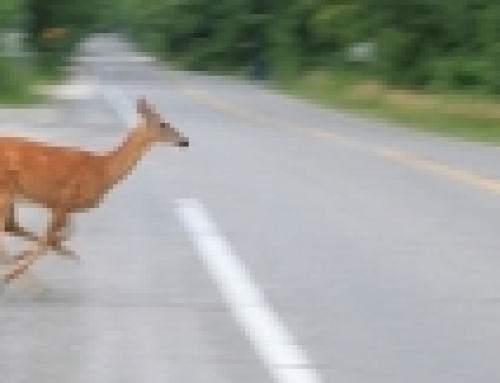
by
Dennis P. (Wombat) Dougherty
Senior Road Captain
We all appreciate the feeling of freedom as the wind blows through our flowing locks (or lack thereof) as we’re cruising down the highways and byways on our trusty iron steed. It is part of the joy of riding. On a ‘no wind’ day the wind force on you and your bike is totally dependent on your speed. If you don’t like that feeling of the skin peeling off your face, back off the gas a bit. If your eyes haven’t teared up yet and the sting from that bug going kamikaze up against your cheek isn’t fulfilling enough, roll on the throttle. No matter what, the wind is always a headwind and flows directly over the handlebars hitting the rider straight on.
However, rarely is there a truly ‘no wind’ day. Most of the time Mother Nature joins in the fun and decides to blow. Depending on how hard she wants to play, she may just tease you a bit, or, if she’s feeling temperamental, she may want to remind you that ultimately she’s in charge of your riding environment and works you a little harder.
A gentle breeze or the occasional puff are no big deal. You’ll hardly notice or require any handling adjustments. Most of the time, experienced riders make minor adjustments with little or no premeditated thought. However, when Mother Nature puts on a blustery show, you need to become more aware of wind direction and speed, the topography of the land you are riding over, what type of bike you are riding and its accessories, and your own skills when riding in less than optimal conditions.
A headwind prior to a turn always becomes a crosswind after a turn. A crosswind can become either a headwind or a tailwind depending upon if you turn toward the wind source or away from it. Maximum effect is felt if the turns are 90 degrees to the direction of the wind. Rarely does a headwind become a tailwind or vice versa unless you do a 180 and head back from whence you came. Coming directly from the front or the back, strong and gusty winds generally don’t cause many stability issues. However, from the side, things can get interesting.
So who cares about this meteorological mumbo jumbo? Well, you should. Especially if you are riding in strong and gusty winds. Why? Unless you’re riding from Hickson to Streeter, North Dakota (the longest straight stretch of road in the US at 123 miles), the wind direction on you and your bike is going to change quite frequently. Depending on how strong the winds and gusts are, it can effect the handling of your bike. You’ll need to be more alert and possibly adjust your riding style to optimize your safety.
If you’re riding on twisties in high winds, the wind hitting you and your bike will be changing constantly, and so should your riding attitude. The same is true on gently curving roads, although not quite as often. As mentioned earlier, heavy or gusty headwinds and tailwinds generally don’t cause too many handling issues. But heavy and gusty crosswinds can, as well as the transitions between them. The impact will vary, depending on whether you’re riding a full dressed cruiser with solid wheels and few ‘holes’ in the bike’s cross section to allow wind to flow through, or a moped. A heavier bike is generally a good thing in high or gusty winds as it takes more wind energy to move it. An open cross section is also usually a help as the crosswind has less metal to push around. However, rarely do you find both extremes on a bike.
Regardless of what you ride or where you are heading, riding in high and gusty winds can be a lot of fun… especially if you are prepared for them. So here are the Top Ten Things To Do When Riding in Heavy Winds.
Top Ten Things to Do When Riding in Heavy Winds
#10: Know When Its Gonna Blow
Check the weather before you go and while underway. Know the wind forecast along your route… both speed and direction. Some weather maps clearly show wind direction and speed all along a route. Learn how to read them… its easy!
# 9: Get Off the Road
If the environmental factors get to the point that they may be outpacing your handling skills and comfort level, Get Off the Road! Don’t push it if you feel your ability to maintain total control of the bike may be compromised. Find a nice café, have a cup of coffee and meet the locals. Time will pass quickly and usually high winds die down after a short period of time.
# 8: Button Up
Keep yourself comfortable, but reduce your wind resistance profile. Secure any loose-fitting clothing and zip up and close any potential ‘inflation points’ in your gear. Allowing the wind to blow you up like the Pillsbury Doughboy or Michelin Man is like hoisting a sail into the wind. If you’re wearing a helmet with a face shield, lower it.
# 7: Take A Break
Riding for an extended period of time in strong, gusty winds can be fatiguing. Pull off the road and take a break from time to time. Fatigue can be a huge contributing factor to motorcycle accidents.
# 6: Wear Eye, Face, and Skin Protection
Generally in high winds, there is more debris in the air being blown about. A small twig in a breeze is one thing, but in a high wind it can become a dangerous projectile. Chances are pretty good you won’t see things coming at you, especially in a crosswind. Protect yourself by wearing good eye protection, such as goggles or wrap around sunglasses. A restraining strap for eyewear is also a good idea to keep them from blowing off your face. Wear a long sleeve shirt or jacket as a first line of defense and to protect your arms and torso. Consider wearing a bandana over your nose and mouth to help protect your face and avoid inhaling foreign matter. If you have a helmet with a face shield… wear it. It’s every persons’ choice in Illinois whether to wear a helmet or not, but in high winds it offers a lot of additional protection.
# 5: Spread Out
If you’re riding with other riders, give each other some extra maneuvering space. The winds may jostle you from side to side. Leave more room between you and especially the riders adjacent to you to allow for any corrections. Some may not be as skilled as you in handling a bike. Avoid crowding others on the ride, but don’t extend the distance to the rider in front of you by so much that you comprise the integrity of the group riding formation. Use common sense. If you’re riding on a Top Cats ride, your Road Captain may put you in single file or increase the spacing distance when riding in formation.
# 4: Anticipate and Plan Ahead
Look down the road at what’s coming at you. Anticipate the direction of the wind, and the effect hills, open range, trees, buildings, and oncoming traffic will have on you. If you’ve been in a crosswind lean on a long stretch of open road and suddenly you come to a building or a grove of trees on the windward side, be prepared for the force of the wind to let up dramatically. Your bike will have a momentary tendency to drift in the direction of the lean. Oncoming traffic can also interrupt wind flow over your bike as well as push wind back onto you from the opposing direction. Be prepared. Don’t let it surprise you.
# 3: Take a Different Track
Choose the road track that gives you the greatest margin of safety. You have three to choose from: Left, Center, and Right. If the heavy crosswinds are variable, stay in the Center track. If they’re coming from the Right, generally the Right track is best. Same is true from winds coming at you from the left side, ride in the Left track. Use your best judgment and consider overall road conditions when making your choice. Choosing a different track can help avoid momentary transgressions across the centerline or off the road and into a potentially unsafe situation as winds toss you around.
#2: Lean Into The Wind
If you are on an extended stretch of open road with a consistent heavy crosswind, consider adding some countersteering and lean into the wind. The amount will depend upon the force of the wind. This will help keep the bike on a straighter track. Remember to release the countersteer if the wind direction or force changes. This works best if the wind is consistent. Avoid this technique if the winds are gusty or vary in direction as it may result in you over-controlling the bike.
… and the #1 thing to do when riding in heavy winds….
# 1: Relax
Rarely do high winds cause motorcycle accidents. However they can be a contributing factor… especially if the rider is not paying attention to what is going on around them. Physics will have a tendency to keep your bike rolling straight and upright. Blustery and heavy crosswinds will generally cause only momentary deviations. The key is to be aware of what is going on in the moment and anticipate what’s up ahead. Keep your arms and hands relaxed. Avoid a ‘death grip’ on the bars so you don’t over control the bike. Keep your head and body straight and upright with your eyes looking down the road. Use similar riding techniques that you would apply when riding over rough terrain. Let the bike move underneath you as it responds to the gusts and try to avoid abrupt maneuvers.
Remember a safe rider is always thinking ahead and constantly adjust their riding attitude (both mental and physical) as riding conditions change. This is especially true when Mother Nature tosses some challenging winds your way.
Ride Safe!





